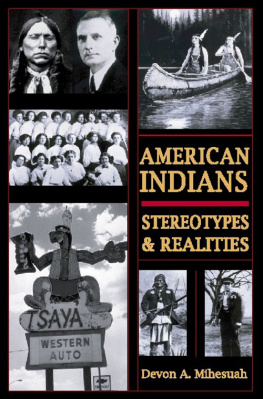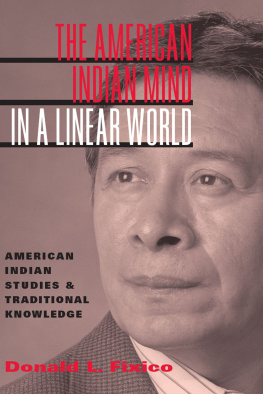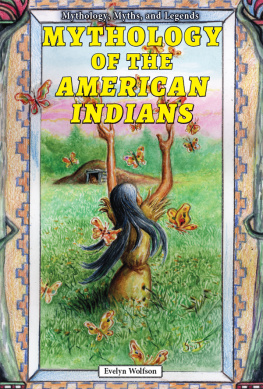Devon A. Mihesuah - American Indians: Stereotypes & Realities
Here you can read online Devon A. Mihesuah - American Indians: Stereotypes & Realities full text of the book (entire story) in english for free. Download pdf and epub, get meaning, cover and reviews about this ebook. year: 2010, publisher: Clarity Press, genre: Politics. Description of the work, (preface) as well as reviews are available. Best literature library LitArk.com created for fans of good reading and offers a wide selection of genres:
Romance novel
Science fiction
Adventure
Detective
Science
History
Home and family
Prose
Art
Politics
Computer
Non-fiction
Religion
Business
Children
Humor
Choose a favorite category and find really read worthwhile books. Enjoy immersion in the world of imagination, feel the emotions of the characters or learn something new for yourself, make an fascinating discovery.
- Book:American Indians: Stereotypes & Realities
- Author:
- Publisher:Clarity Press
- Genre:
- Year:2010
- Rating:5 / 5
- Favourites:Add to favourites
- Your mark:
American Indians: Stereotypes & Realities: summary, description and annotation
We offer to read an annotation, description, summary or preface (depends on what the author of the book "American Indians: Stereotypes & Realities" wrote himself). If you haven't found the necessary information about the book — write in the comments, we will try to find it.
American Indians: Stereotypes & Realities provides an informative and engaging Indian perspective on common misconceptions concerning American Indians which afflict public and even academic circles to this very day. Written in a highly accessible stereotype/reality format, it includes numerous illustrations and brief bibliographies on each topic PLUS these appendices:
- Suggested Guidelines for Institutions with Scholars who Conduct Research on American Indians
- Course outline for American Indian history and culture survey with suggested projects
- Outline for course American Indian Women in History with extensive bibliography
An American Indian perspective on discrimination issues WIDELY ENDORSED BY AMERICAN INDIAN SCHOLARS
Professor Mihesuah goes beyond simply providing responses to common stereotypes. She provides the reader with assistance in efforts to improve understanding of her peoples. Each of the chapters provides solid information to challenge myths and stereotypes. Excellent photographs are interspersed throughout the book.... The implications of this book for social work practice are extensive... A valuable contribution Journal of Multicultural Social Work
A precious primer on Native Americans for anyone who can handle the truth about how the West was won. Kam Williams, syndicated
This book should be read by every educator and included in the collections of every school and university library. Flagstaff Live
Mihesuahs work should be required reading for elemetary and upper level teachers, college instructors and parents. Let us hope it finds a wide readership in mainstream circles. Joel Monture, MultiCultural Review
Devon Mihesuah has provided precious insight into the racial identity and cultural struggles of American Indians as they strive to succeed in modern America. She has successfully challenged harmful stereotypes and racism in this significant book... If an accurate history is to be learned, then society must accept the truth of cultural pluralism and give equal and fair treatment to Native Americans and other minorities... As an American Indian and a university scholar of history, I applaud Devon Mihesuah for successfully confronting the literature of false portrayal and negative images of Indian people.
Dr. Donald L. Fixico, Western Michigan University, Kalamazoo
Devon A. Mihesuah: author's other books
Who wrote American Indians: Stereotypes & Realities? Find out the surname, the name of the author of the book and a list of all author's works by series.






